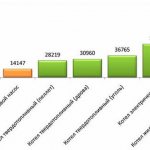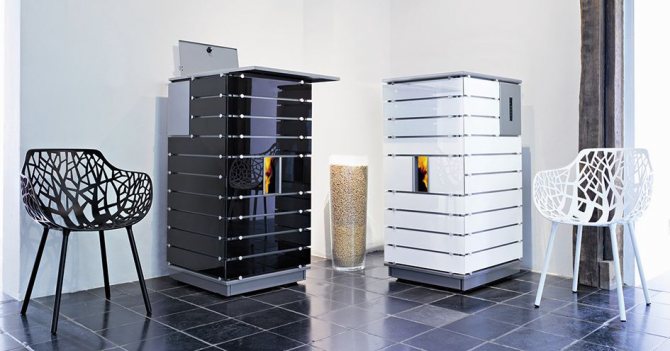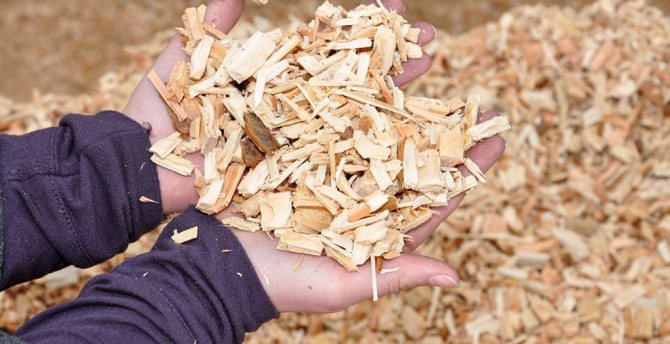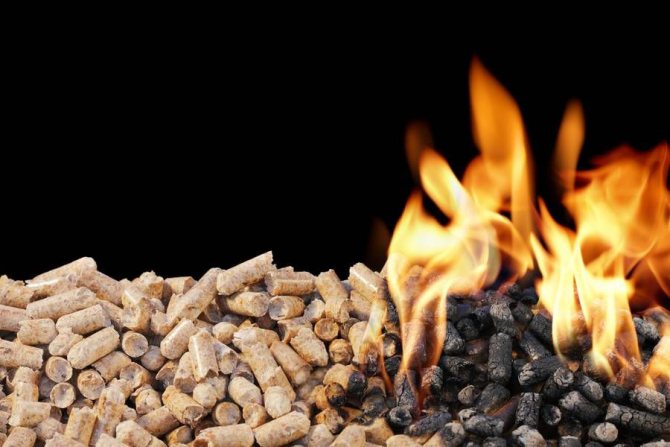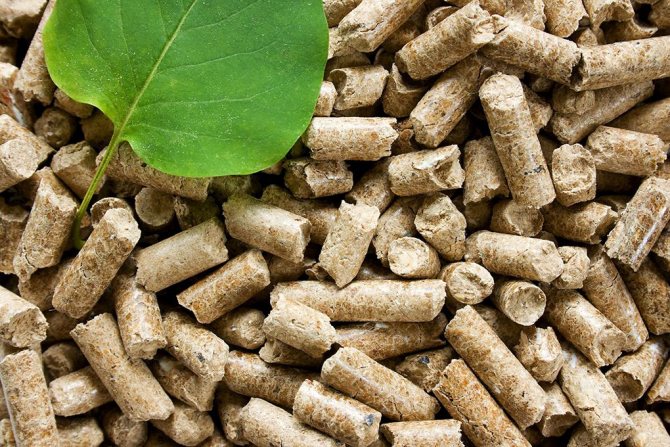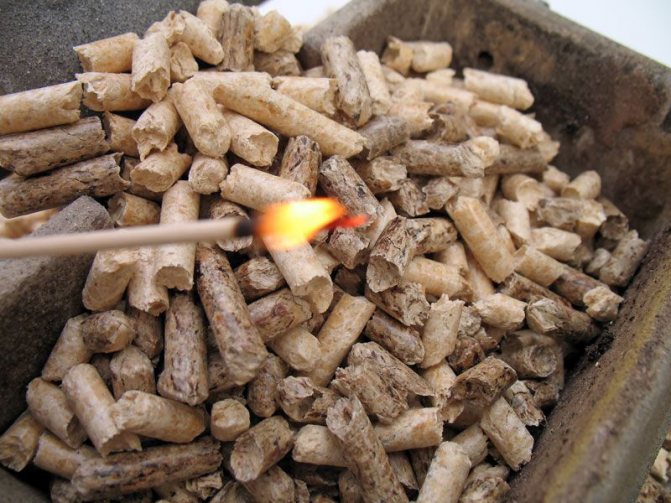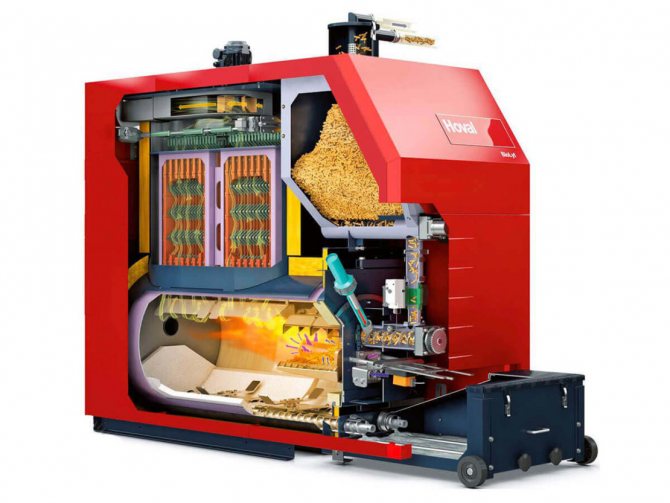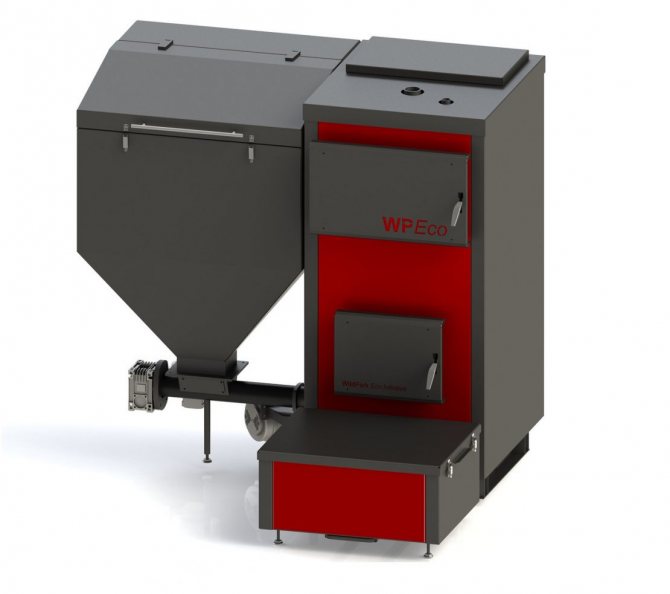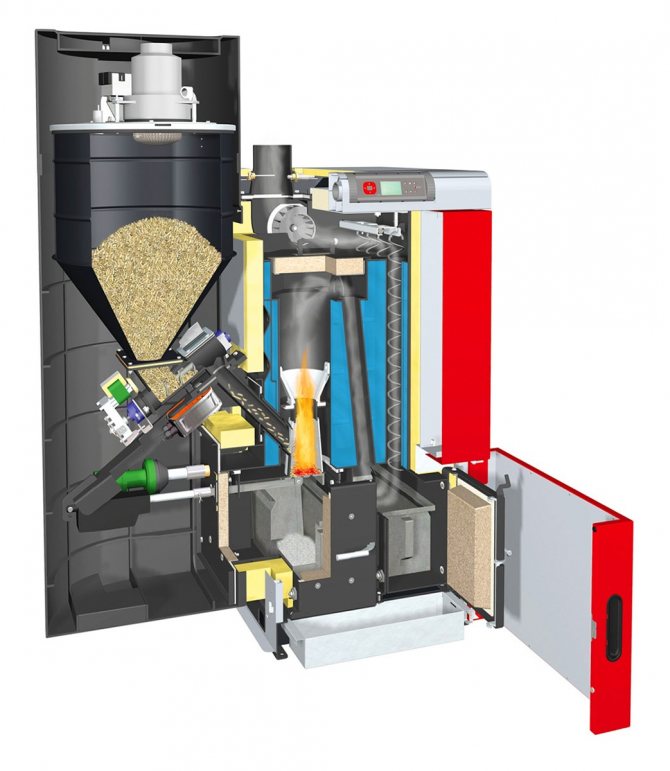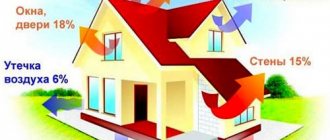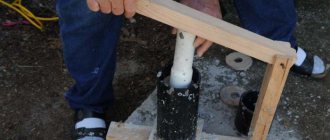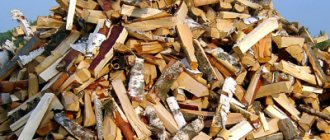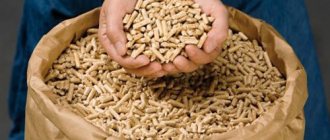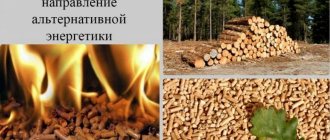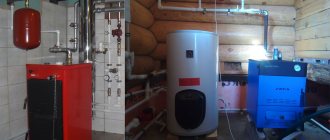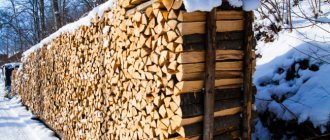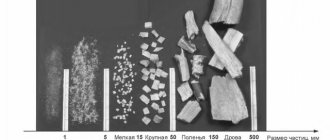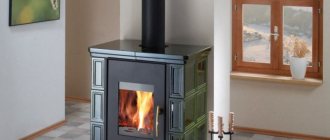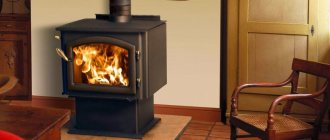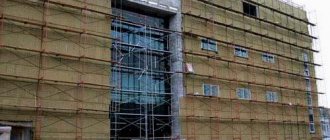Comparative characteristics of fuel
The fuel cost is presented in the table (average prices):
| Name | Price including delivery in Moscow (volume from 20 tons) | Shipping price from the warehouse (volume from 1 ton) |
| Sunflower husk pellets | From 53 $ (3500 r) per ton | From 68 $ (4500 r) per ton |
| Light wood pellets from 6 mm | From $ 101 (RUB 6700) per ton | From 109 $ (7200 r) per ton |
| Light wood pellets from 8 mm | From $ 95 (6300 r) per ton | From 103 $ (6800 r) per ton |
| Birch fuel briquettes | From 87 $ (5800 r) per ton | From 89 $ (5900 r) per ton |
Comparative characteristics of heating costs are shown in the photo.
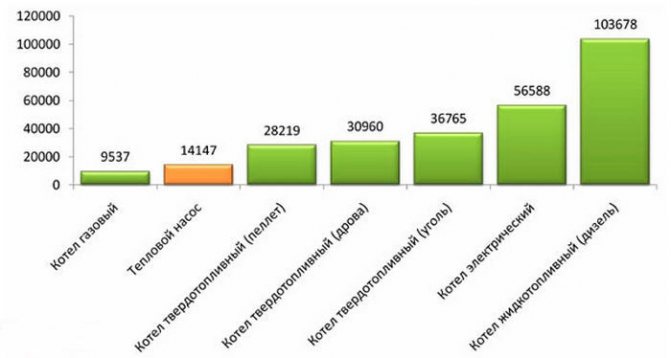
It is noticeable that when using granular fuel, the cost of maintaining the system is slightly higher than using gas equipment, but much lower than any other devices operating on a standard type of fuel.
Characteristics of heating costs with pellets
The average daily consumption rate will be up to 60 kg, within 6 months you will spend about 10 tons of pellets, which with an average ceiling price of 3600 rubles per ton will be at least 36 thousand. For comparison: heating with a coal briquette or coal will cost about 20-22 thousand rubles, when using gas, heating will increase in price by 15%. The calorific characteristics of pellets are clearly inferior.
In addition, for productive combustion and use of heat, a special pellet boiler is needed, with fittings and control systems, it will cost at least $ 1300-1400. In fact, this is the price of a two-year supply of pellets.
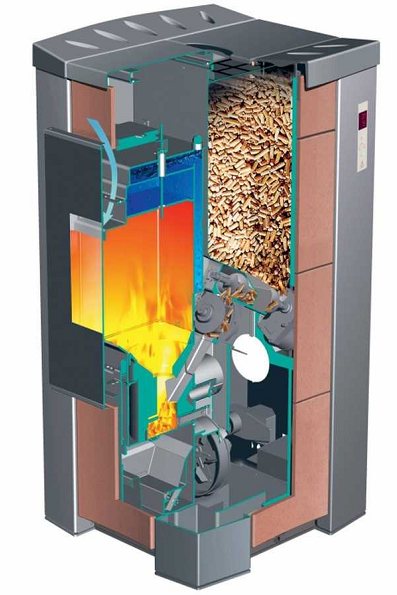

In the wake of popularity, many Western manufacturers have figured out to occupy a niche of boilers using fuel pellets and more advanced characteristics. The most popular now are boilers-fireplaces that can be installed even in high-rise apartments.
How to determine the quality of fuel pellets
The cost of raw materials depends on the quality, the class of pellets, the average prices of pine pellets start at $ 90 (6000 r) per ton, and peat fuel is estimated at $ 83 (5500 r) per ton. The cost of pellets for heating depends on a specific region, supplier, but in general, the spread does not exceed 500 rubles per ton.
The quality of the pellets determines the efficiency of the heating system. You can visually determine the indicators of fuel raw materials.
What to look for:
- Dust. If there is a lot of dust in a bag or package, this indicates a substandard product.
- The evenness of the surface of the granules without cracks and blisters indicates compliance with the processing technology and product preparation.
- Color. It should be even without centers of lightening, darkening. If the shade of the granules is gray, then they have been lying for a long time and the quality will be low.
- Granule length. The European standard that manufacturers adhere to is 25 mm. But fuel cells can be longer or slightly smaller, size does not affect the overall combustion efficiency.
- Smell. Good quality fuel should have a sweetish aroma - it appears during processing and drying. If there is a smell of rot, burnt product, harsh chemistry - the manufacturing process is disrupted, it is better to refuse granules.
Advice! The alternative fuel product may smell like the raw material it is made from. Therefore, sunflower husk pellets sometimes smell like oil, wood pellets - with shavings, peat - with smoke.
How to make pellets with your own hands: stage number 1
We will grind all the ingredients on a coffee grinder. As a result, we should get less than 4 glasses.
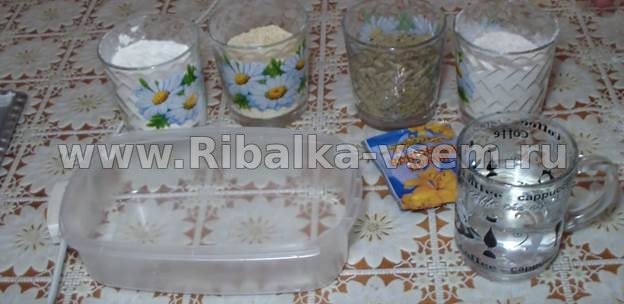

The proportions are the same. You can add flavoring if desired. In this case, we will add a bag of vanilla sugar. You can also add fruit essence, slightly diluted in water.
As for the ground seeds, it is better to overcook them yourself either in the microwave or in a frying pan. In this case, it is necessary to ensure that the seeds are evenly roasted. If possible, it is better to buy corn chaff in a store or at a poultry market.
Pour all the ingredients into a container and mix them well until smooth.
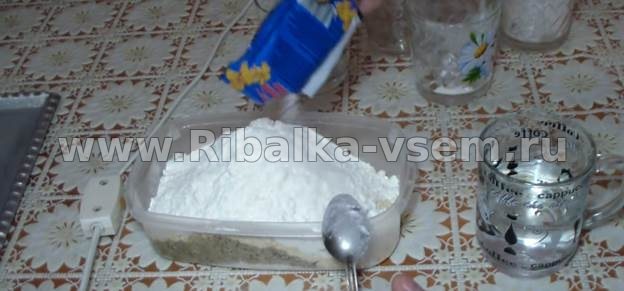

After mixing, add a mug of water. We pour evenly, not all at once. Poured a little and mixed. After that, the procedure was repeated and mixed again.
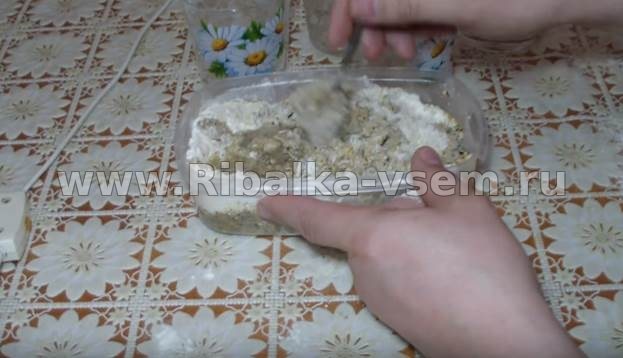

Stir until tight. As a result, we should get such a lump, similar in density to the dough.
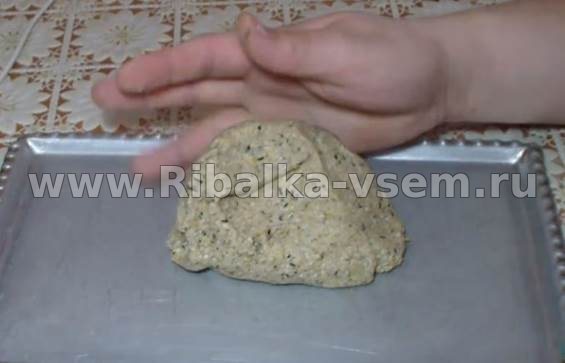

We leave this piece for 1 hour so that it is well saturated.
Pellet classification
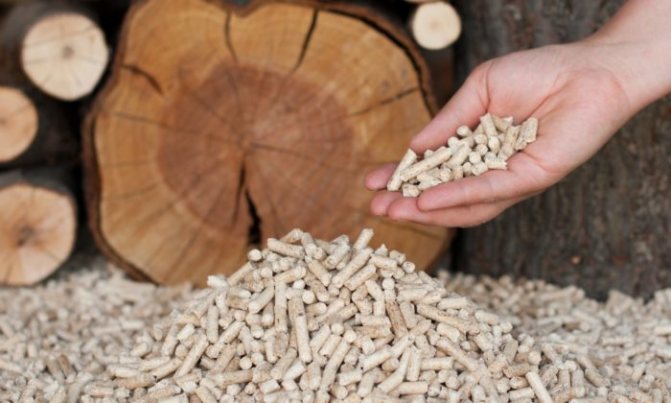

According to the technological classification, products are divided as follows:
- White. This is a premium class. Well-dried wood without bark is used in the manufacture. The ash content of the fuel is not more than 0.5%, therefore, granular products are used for all types of solid fuel equipment. The ash removal process is carried out once a month, the heat generation is 17.2 megajoules per 1 kg of products.
- Industrial pellets. These are granules, in the production of which raw materials are used with dust, soil, bark, and other inclusions. Ash content is high, heat generation is also 17.2 MJ / 1 kg of fuel. The regularity of cleaning the combustion chamber more often, the parameter is indicated in the technical documentation for the granules.
- Agropellets. Fuel that has been assigned a standard class. Sunflower husks and buckwheat are used as raw materials. Distinctive features - dark color, low heating capacity (no more than 15 MJ / 1 kg), high ash content. But there is a plus - a reduced cost. Alternative fuels are used at thermal power plants and in boilers with an automatic cleaning function. Otherwise, the ash will have to be cleaned every day.
Important! When choosing pellets for heating, it is necessary to evaluate the individual characteristics of the region. In areas with a developed agricultural economy, the use of agropellets will be an inexpensive option for generating heat, and wood pellets are cheaper in areas with wood processing enterprises.
Requirements for raw materials for the manufacture of pellets
1. The moisture content of raw materials should not exceed 12%. Therefore, materials for the manufacture of pellets are pre-dried.
2. Special equipment is used for drying - a drying drum.
3. Choose raw materials that are high in glue, resin and lignin. In this case, the granulation process is accelerated, and the finished product keeps its shape well.
4. Raw materials should not contain foreign objects, debris, stones, therefore, they should be sieved beforehand.
Pellet types
- White. It is a premium fuel with the highest performance (and price). Named for its characteristic color - light yellow, almost white. But the color is secondary, the characteristics are primary and the main one is a very low ash content. After the combustion of white ash pellets, no more than 0.5% of the fuel volume remains. The boiler will need to be cleaned very rarely. White fuel pellets are produced from shavings without bark and other foreign inclusions. As a rule, this is carpentry or furniture production.
- The gray ones. Raw materials for this type of pellets may contain a certain percentage of bark, needles and some other impurities. But the ash content should not be more than 1.5%.
- Industrial or dark pellets. This type of fuel pellets is made from straw or cake in pure form or with the addition of wood waste. The ash content of this type of fuel is much higher than that described above, however, it cannot be higher than 5%.
White and gray pellets are used for individual heating. They are also called "first class" or first class. They have a diameter of 6-8 mm, a density of about 600 kg / m3, the amount of heat generated is about 4.7 kW / h.They are burned in special boilers, which are called pellet boilers. Usually this equipment is very demanding on the quality of the fuel. In addition to low ash content, requirements are imposed both on the integrity of the granules and on the absence of a dust-like fraction. Otherwise, the pellet boiler burner becomes clogged, the boiler shuts down. Industrial pellets are also burned in special stoves, but they have a completely different structure and much larger volumes.
Characteristics of pellets from different raw materials
REVIEW OF PRICES FOR HEATING PELLETS
Pricing of heating pellets is based on many factors. First of all, these are the raw materials that were used in their production.
Industrial pellets (gray) are cheaper than household pellets (white). Their cost varies from 4250 rubles per ton to 6 thousand. The price of white pellets can be up to 7500 rubles. Such a high cost is the case with pellets, which consist of pure waste of hard wood species, mainly aspen and oak.
Also, the price depends on the amount of pellets purchased. At the same time, retail starts from one bag (15 - 45 kilograms), and wholesale deliveries can reach up to 100 thousand tons per month. Each company has its own system of discounts.
An important factor in determining the price is the region in which the manufacturer is located. If it is a woodworking area where there is a lot of quality waste, the cost will be minimal.
The final cost is influenced by the distance between the buyer and the seller. Many companies carry out delivery for an additional fee or only for large orders. Therefore, it is easier to buy fuel pellets in your region.
The main characteristics of pellets
Dealing with the type and classification, one can understand what pellets are - they are waste of wood processing, agricultural crops, peat, coal. Granular fuel is obtained in the process of pressing waste under high pressure (more than 300 atmospheres) and elevated temperatures. The raw mass is passed through certain forms, from where it comes out in the form of capsules, granules. Particles of the substance stick together without the use of chemicals, so heating a house with pellets is considered one of the most environmentally friendly. Standard size of granule thickness is 6-10 mm, length is 20-30 mm.
What is the peculiarity of the use of granules - pellet heating is performed by pressing, therefore, it emits much more heat energy. For example, in comparison with other fuels, 1 ton of pellets replaces 0.5 ton of diesel, 480 m3 of gas or 1.6 ton of firewood. Choosing encapsulated raw materials reduces the amount of waste in the form of ash. Some minus in the high cost, compared to firewood, but here you have to choose - buy firewood for sawing or bags of granules.
On a note! In addition to wood, bark, coal, peat, agricultural waste, household solid waste is used for manufacturing - such granules do not have high heat transfer, but are cheap and therefore are quite suitable as a reserve stock.
Pellet production
Thanks to the use of agricultural and forestry waste, the pellets of fuel pellets themselves are environmentally friendly, respectively, the characteristics of ash and combustion products look very good and do not pose a danger to household consumers. An important contribution to such an important characteristic is added by the use of specific equipment for the production of pellets. The often compact but powerful pressing equipment allows you to organize the use of waste directly at the point of receipt. For example, next to a sawmill or a wood processing plant.
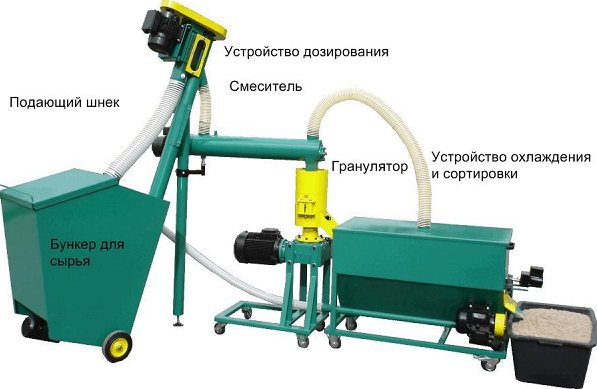

Pellet manufacturing technology
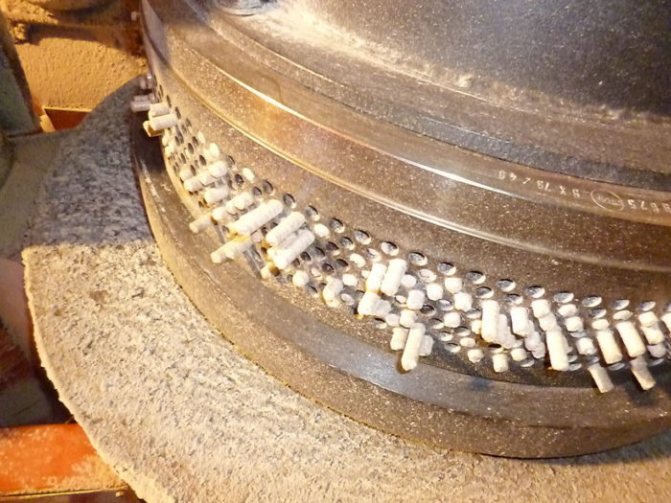

Solid fuel boilers for long burning for home heating
Raw material passes through several stages in the process of preparation and receipt of the final product:
- Splitting up.The procedure for grinding waste allows you to obtain a fine-grained composition of granules whose dimensions do not exceed 2x25x25 mm. This is to facilitate drying.
- Drying. There are several ways to carry out this stage, it all depends on the type of equipment used in production. The basic rule is that after drying, the moisture content of the raw material should not be more than 10%.
- Additional grinding. A hammer mill is used, which crushes the granules into fractions up to 4 mm in size.
- Moisture enrichment. The substance is passed through a screw mixer and absorbed with moisture.
- Pressing. Presses of various types are used, through which the mass is passed, leaves the sieve and is cut with a knife - the process is automated, the temperature regime is maintained within +100 C.
- Cooling and packing.
Important! If, during the pressing process, the temperature regime exceeds +120 C, the material loses its combustible properties - this reduces the heat transfer of the pellets.
Homemade pellets
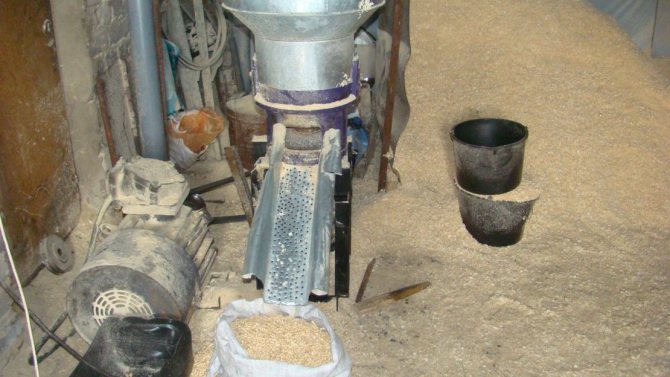

For self-production of pellets, you need to stock up on the following equipment:
- a crusher is needed if the raw material needs to be crushed, but in the case of using already crushed material, this unit can be dispensed with;
- a granulator with a flat or cylindrical matrix (it is easier to make a flat device with your own hands from scrap materials);
- drum or aerodynamic dryer (you can make it yourself from a metal barrel);
- secondary crusher.
In the case of using a flat granulator, a crusher is not needed, because the grinding of raw materials will take place in the same device. The need for a dryer depends on the moisture content of the starting material.
Prepare the required raw materials. There should be no foreign impurities in it. To do this, it is sieved. The optimum humidity is 12%. To accelerate granulation, the starting material must contain natural glue, resins and lignin.
From sawdust
When using sawdust for the production of granules, the following technology is observed:
- The sawdust is pre-dried to a moisture content of 12%.
- After that, the raw material is sieved through a sieve to remove various impurities.
- The sawdust is then fed to a hammer mill.
- If the moisture content of the raw material does not exceed 8%, the material is additionally treated with hot steam.
- The wet mass is compressed to give it the desired granule shape.
- Then the pellets are cooled and dried, after which they are packed in paper bags.
From straw
The heating capacity and ash content of such granules is high. To produce them, you need a special crusher. Dry reeds can be used instead of straw. The pellet production process is the same as described above. The resulting pellets are suitable for home heating with a stove and fireplace.
From peat
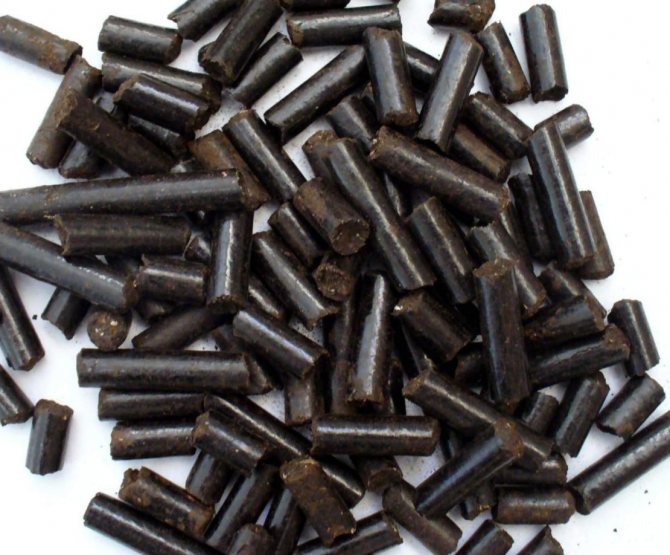

Peat pellets are made like this:
- Peat is dried naturally.
- Dry raw materials are cleaned from various impurities, stones and foreign plants.
- The prepared mass is crushed.
- In a special dryer, the raw material is dried until a moisture content of 12% is reached.
- Then the peat is crushed and formed into cylindrical granules, which are subsequently treated with dry steam.
- After cooling, the pellets acquire the required density and strength.
Peat granules are used not only to heat the house, but also in the production of sorbents to enhance the effect of the use of mineral fertilizers. In addition, the material is suitable for neutralizing oil that has entered the reservoir.
Devices for the use of fuel pellets
Wooden pallets are used for heating (as well as made from other types of raw materials) in devices specially designed for these purposes. These are boilers, fireplaces with their own characteristics and features.
Fireplaces for loading pellets
They are used for heating individual rooms or houses with an area of up to 20-25 m2.
The average power of the devices is 6-15 kW, there are three types of devices:
- convection heating air;
- with a circuit for hot water supply - they can heat water;
- combined - used for heating water and air.
On a note! Combined fireplaces can work on pellets, briquettes, wood fuel.
Boilers for loading pellets
These are pellet heating systems with a capacity of up to 100 kW, therefore, they are used in houses with an area of up to 100 m2, they allow the formation of circuits with a liquid heat carrier for underfloor heating or an autonomous heating system. It is recommended to install boilers in basements or specially equipped rooms, as well as in detached buildings.
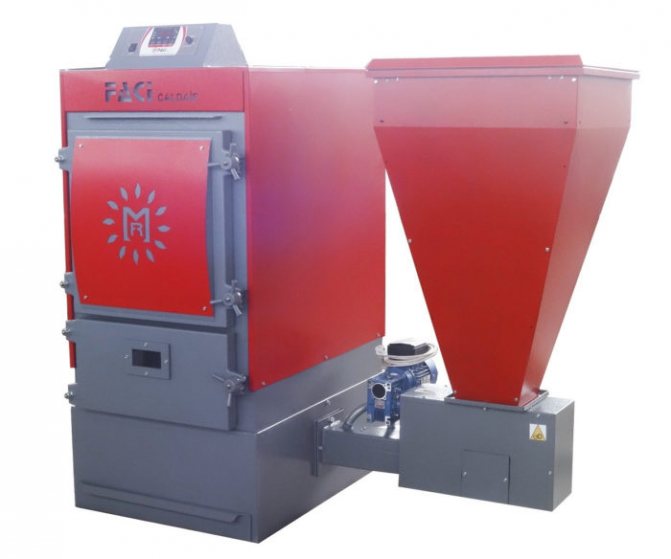

The efficiency of boilers depends on the type of equipment; there are devices on sale that work:
- only on granules;
- on pellets, wood or briquettes;
- combined types of equipment that allow the use of any type of solid fuel.
Worth knowing! The power and efficiency of the boiler depends on the type of fuel used. The parameters are prescribed in the product data sheet.
Pellet boiler arrangement
The main difference between the equipment is in the small volume of the combustion chamber due to the flow of the main processes not in the chamber, but in the convection part of the units.
Other distinctive features include:
- Special type burners with high efficiency.
- Long service life. With the correct operating technique, boilers serve for at least 20 years.
- High degree of equipment automation. Automation helps to establish the regularity of fuel supply, set the heating temperature.
Experts advise choosing devices with a capacity of 15-100 kW for a private house, but you can use the formula for 10 m2 you need 1 kW of thermal energy, plus a margin of 15-20%.
Advice! If you need a heating device in a room with a capacity of less than 15 kW, it is wiser to put a fireplace.
Benefits of pellet heating
The advantages include the following indicators:
- no need for regular maintenance of boilers;
- there are no unpleasant odors in the combustion process;
- high efficiency;
- convenience of storage and transportation of fuel;
- the ability to establish hot water supply in the presence of a water circuit (available in almost all boilers);
- ease of installation - you can do it yourself.
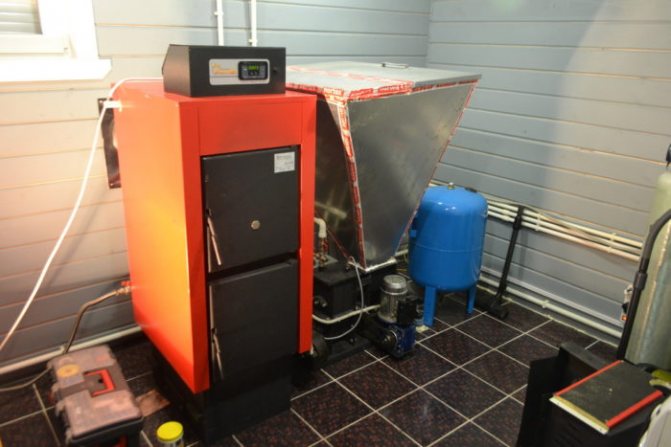

Combined heating boilers for a private house
Important! The efficiency indicator is influenced by the calorie content of the pellets for heating. The highest level is for wood raw materials, lower for pellets from household waste. For storing fuel, you need to equip a well-ventilated compartment protected from water and snow.
Disadvantages of pellet heating
The disadvantages include:
- The high price of boilers. The equipment costs a lot more than gas or electrical appliances.
- The need for ash removal. It all depends on the boiler model, but even in old types of equipment, the ash pan should be cleaned no more than 1-2 times a week.
- Heating with pellets is more expensive than a system with a gas boiler.
- There may be interruptions in the delivery of granules.
Important! When choosing a boiler, it is necessary to look at the adaptation of the device to the conditions of the region of operation. Not every boiler from a foreign manufacturer will withstand power surges and work in an increased mode (in severe winters).
Making pellets with your own hands
The process can be difficult, you need special equipment.
The master will come in handy:
- crusher, but not when using sawdust, husks - this raw material is sold crushed;
- granulator with cylindrical or flat die;
- aerodynamic or drum dryer (you can make it yourself from an iron barrel);
- secondary crusher.
Important! If the master has a flat die granulator, no crushers are required. The crushing process takes place in a granulator.
How to make a do-it-yourself granulator is shown here.
It all starts with the preparation of raw materials and here you need to follow the rules:
- The raw materials must be clean without impurities. The whole mass should be sieved.
- Humidity not more than 12%. Before starting work, the raw material is dried to the desired value.
- The absence of lignin and resins is a bad indicator.The more components, the faster the granulation will be, the fractions will not fall apart after manufacturing.
- A special drum is used for drying.
And now there are several ways to make pellets, depending on the feedstock.
Sawdust pellets
The algorithm of actions is as follows:
- dry the mass to the desired moisture content of 12%;
- sift sawdust through a sieve to eliminate mechanical impurities;
- run the mass into a hammer mill;
- if the moisture content of the material is below 8%, treat the raw material with wet steam;
- compress the granules and let cool;
- pack in paper bags.
It remains to store the fuel in a dry and ventilated shed.
Straw pellets
High ash content of raw materials is a minus, but increased energy efficiency and low cost are pluses, therefore straw is often used for the preparation of pellets. However, there is a difficulty with the equipment - for straw, a large-sized crusher is required, which must be purchased or made by yourself. Both waste from grain processing and raw materials from chopped reeds are loaded into the crusher.
The equipment is used the same as in the previous example, and the fuel is used for fireplaces, stoves. The difference is the need for frequent cleaning of the ash pan, however, high efficiency and a very large amount of heat make up for the disadvantage.
Peat pellets
How to do:
- dry raw materials in natural conditions;
- to clear the mass of stones, impurities, plants;
- grind the entire substance;
- dry the mass to the desired indicator of 12%;
- re-run the mixture into the chopper;
- pass the mass through a press and process the final product with hot dry steam;
- chill granules to cure and can be used.
The use of peat granules is wide - they are used to enhance the effect when applying mineral fertilizers and purify water from oil if it gets into the tank.
Fuel pellets for the boiler - heating with pellets. Types, varieties, production of pellets
Pellets or granules - modern, environmentally friendly and renewable fuel intended for use in heating cottages, private houses, as well as industrial buildings using special fireplaces and boilers.
Fuel pellets (pellets) for heating
Pellets are made from wood processing waste, agricultural products and waste from other sectors of the national economy by pressing into small cylindrical granules (granule diameter - 6 ... 10 mm, length - 50 mm), photo 1.
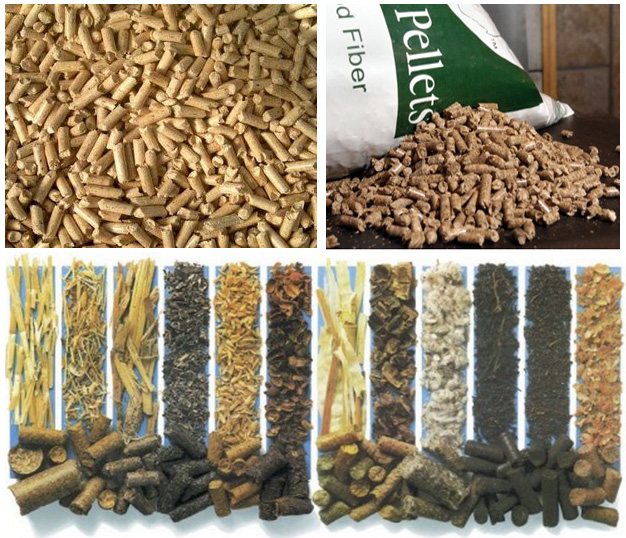

Photo 1. Pellets
Pellet boilers are characterized by ease of installation, automation of regulation and management of the heating process.
Pellet boilers are divided into two types:
- with a remote burner (for industrial enterprises);
- with an integrated burner (for private houses, cottages).
Pellets are widely used in Western Europe and North America. In some European countries, heating of private houses with pellets reaches 50%. In 2008 Europe the largest amount of pellets is produced:
- in Sweden - more than 1.7 million tons;
- in Germany - 900 thousand tons;
- in Austria - 800 thousand tons.
The global consumption of pellets is approximately 22.5 million tons. (2013), and in Europe, 2/3 of the heated areas are heated with pellets.
What types of pellets are there?
Pellets or granules are of the following types, photo 2:
- woody (most common);
- coal;
- peat;
- from vegetation (for example, buckwheat husk, sunflower);
- straw pellets;
- from corn waste;
- from chicken droppings;
- from solid household waste.
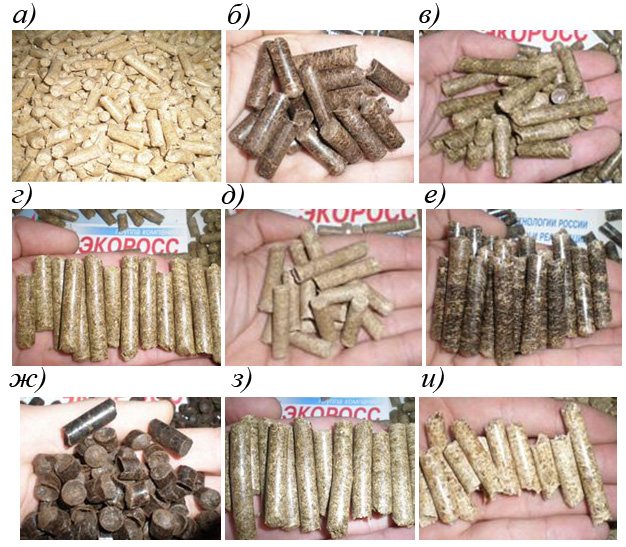

Photo 2. Types of pellets made from: a) birch sawdust; b) buckwheat husk; c) rape stalks; d) rye (straw); e) rice husks; f) the husks of sunflower seeds; g) peat; h) barley (straw); i) pine sawdust
The most efficient and high quality wood pellets are suitable for domestic solid fuel boilers operating on this fuel.Pine pellets, which are practical in use, have proven themselves especially well: they have high strength, do not crumble into powder during transportation and overloading.
It is not recommended to use for household boilers:
- pellets from other raw materials (except wood);
- pellets, in the production of which chemical adhesives were used (a high probability of the release of toxic gases during combustion).
- pellets of poor quality, with an admixture of soil and sand particles, which leads to the deposition of slags on the elements and walls of the boiler combustion chamber.
The above-mentioned pellets lead to a decrease in efficiency and a reduction in the service life and durability of the boiler.
What types of fuel pellets are there?
The following types of pellets are produced:
- top grade "premium", they are also called "white". The cost is high compared to other varieties due to the higher quality raw materials. The color is white, beige, light brown. Raw materials for such pellets are sawdust of oak, beech and other hard species;
- industrial (industrial). They have dark colors due to the addition of bark to the composition. The calorific value is high, but the ash content is higher - 0.7% or more. The cost of such pellets is lower than premium grade pellets;
- agropellets "standard" (a kind of industrial pellets). They are made from sunflower husks and buckwheat. Pellets are dark in color, have a high ash content - 3% or more, low calorific value - 15 MJ / kg, tab. 1. The cost of agricultural pellets is the lowest. Agropellets are designed for thermal power plants and industrial boilers.
Comparative characteristics of buckwheat and wood pellets
Table 1
| Type of fuel | Heat of combustion, kcal / kg | Cost, $ |
| Buckwheat husk pellets | 4300 | $ 115 / t |
| Wood pellets | 4500…5000 | 150 ... 180 $ / t |
Important! When choosing pellets for heating a private house, you should pay attention to the following points and indicators:
- a quality certificate for pellets (composition), compliance with applicable standards should be required. It is desirable that the pellets meet such European standards as EnPlus, DinPlus;
- calorific value (not less than 4200 kcal / kg);
- ash content (no more than 0.5 ... 1%);
- humidity (no more than 8 ... 14%).
The boiler efficiency depends on the calorific value, ash content and moisture content. You can also visually determine the quality of the pellets. High-quality pellets have a smooth, shiny surface without visible longitudinal cracks, must be strong and not break easily under the hands. The color can be different: from light beige to brown. The color does not affect the quality of the pellets.
Advantages of using pellets for space heating
- High efficiency of pellet boilers.
- High calorific value. For example, 2 tons of wood pellets during combustion emit an equivalent amount of heat equal to the combustion of 1000 liters of diesel fuel, 3.2 tons of wood, 1370 liters of fuel oil and 957 m3 of natural gas. From table. 2 and tab. 3 it can be seen that pellets generate more heat during combustion than sawdust or wood chips.
Comparative characteristics of different types of fuel
table 2
| Type of fuel | Calorific value MJ / kg | % sulfur | % ash | Carbon dioxide kg / GJ |
| Coal | 15…25 | 1…3 | 10…35 | 60 |
| Diesel fuel | 42,5 | 0,2 | 1 | 78 |
| Fuel oil | 42 | 1,2 | 1,5 | 78 |
| Wood chips | 10 | 0 | 2 | 0 |
| Wood pellets | 17,5 | 0,1 | 1 | 0 |
| Peat pellets | 10 | 0 | 20 | 70 |
| Straw pellets | 14,5 | 0,2 | 4 | 0 |
| Natural gas | 35 ... 38 MJ / m3 | 0 | 0 | 57 |
Note: "0" means that when fuel is burned, the amount of СО2 is equal to or less than the amount of СО2 during the decomposition of this fuel.
Calorific value of pellets and other fuels
Table 3
| Type of fuel | Heat capacity, kcal / kg |
| Pellets | 4500 |
| Firewood | 2500 |
| Charcoal | 7500 |
| Coal | 7400 |
| Fuel oil | 9800 |
| Diesel fuel | 10200 |
| Natural gas | 8300 |
- Simple storage conditions for pellets.
- Low ash formation. The boiler is cleaned from ash 1 ... 2 times a week. The amount of ash from the combustion of pellets is 10 ... 20 times less than in the case of using firewood.
- The combustion efficiency of pellets reaches 99.3%.
- Automatic regulation of combustion temperature.
- Automatic loading of fuel into the combustion chamber, photo 3.
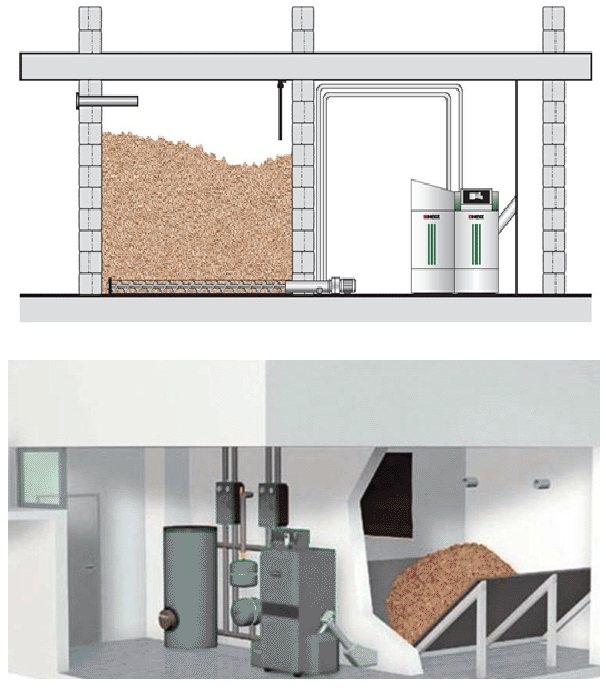

Photo 3.Automatic loading of fuel into the combustion chamber
- High resistance to spontaneous combustion.
- Eco-friendly fuel. No chemical binder is used in the manufacture of granules. The granules are produced by compressive force. The adhesive is lignin, which is released during compression. Wood pellets when burned have 10 ... 50 times lower emission of carbon dioxide and 15 ... 20 times less ash formation than when burning coal.
- Do not rot, do not swell (peat, coal pellets).
- Relatively low price compared to natural gas and other fuels. The wholesale cost of 1 ton of pellets is 110 ... 130 $.
- High bulk density, which allows large quantities to be transported in one truck.
- High durability of pellet boilers (over 20 years).
Disadvantages of using pellets
- To burn pellets, a special boiler is required or a solid fuel boiler should be converted.
- When purchasing fuel pellets in small quantities, their price will be quite high.
Pellet production technology
- Coarse crushing... Raw materials (sawdust, wood chips, bark) are crushed and ground into sawdust and flour using special crushers and mills.
- Drying crushed material to a moisture content of 8 ... 10% in drum or belt dryers, photo 4.
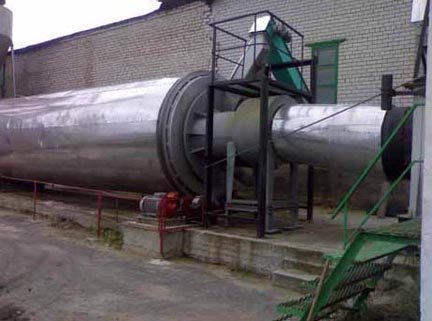

Photo 4. Drying of crushed material in dryers
- Additional crushing of raw materials in hammer mills up to a particle size of 4 ... 6 mm.
- Compression (pressing) under pressure on a pellet press at a temperature of 110 ... 120 ° C, photo 5. A pellet press is available with a flat or cylindrical die, roller or screw type, photo 6. The productivity of a mini pellet press can reach 200 ... 250 kg / h.
- Cooling pellets (as needed).
- Packaging pellets in bags, photo 7.
It is calculated that for the production of 1 ton of pellets, 2.5 m3 of wood waste is needed, and according to other sources, 5 ... 6 m3 is required. Household pellets are produced in bags of 15 ... 30 kg or industrial pellets of 300 ... 1000 kg.
Examples of lines for the production of wood pellets are shown in photo 8. The cost of a small line based on OGM-1.5 is about $ 55,000. The cost of industrial lines is much higher and depends on the performance:
- 100 ... 700 kg / h - about $ 132,000;
- 2000 kg / h - about $ 196,000.
Peat pellet production consists of the following stages:
- preliminary light grinding;
- drying of peat;
- pressing;
- packaging.


Photo 5. Pressing pellets
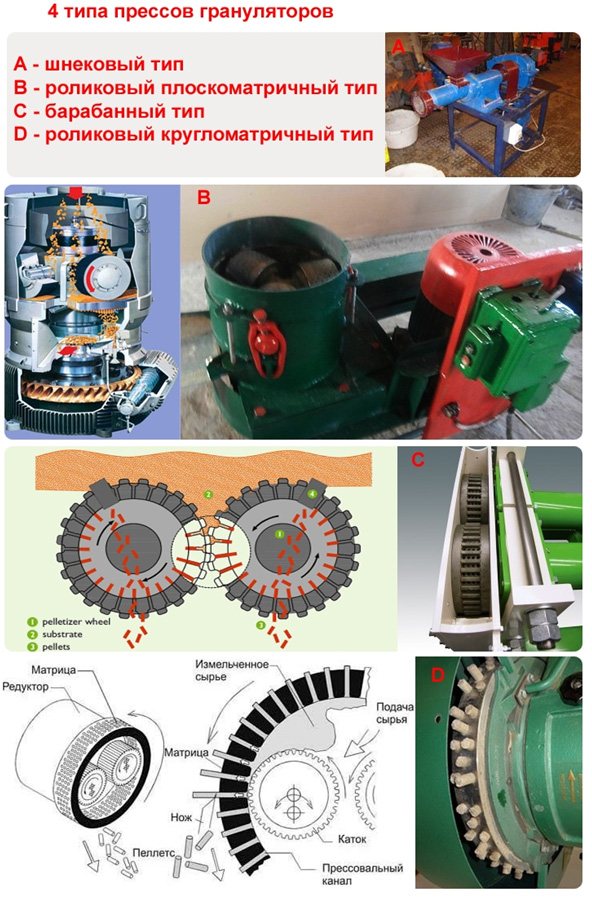

Photo 6. Types of presses for the manufacture of granulators


Photo 7. Packaging of pellets
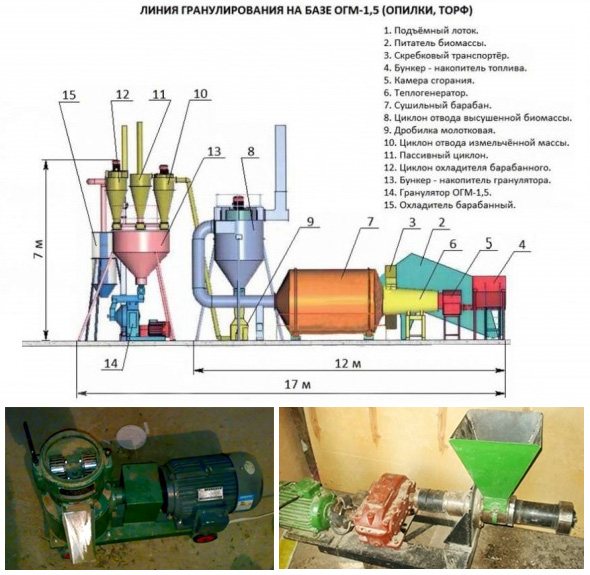

Photo 8. The main units of the lines of granulation and pellet production
Different countries have their own quality standards for pellets. In the CIS countries, there are still no state standards for the use and production of pellets.
Here are some of the standards in different countries:
- USA - Standard Regulations & Standards for Pellets in the US, pellets of 2 grades are produced: "Premium" and "Standard";
- Germany - DIN 51731;
- Austria - ONORM M-7135;
- Great Britain - The British BioGen Code of Practice for biofuel (pellets);
- Switzerland - SN 166000;
- Sweden - SS 187120.
Table 4 shows the main European quality standards for pellets.
The main European quality standards for pellets
Table 4
| Characteristic | DIN 51 731 | Onorm M-7135 | DINplus | SS 187120 |
| Germany | Austria | Germany | Sweden | |
| Diameter (mm) | 4-10 | 4-10 | ||
| Length (mm) | < 50 | <5 * d | <5 * d | <5 * d |
| Density (kg / dm3) | > 1,0…1,4 | > 1,12 | > 1,12 | — |
| Moisture (%) | < 12 | < 10 | < 10 | < 10 |
| Bulk weight (kg / m3) | 650 | 650 | 650 | 650 |
| Briquette dust (%) | — | < 2,3 | < 2,3 | — |
| Ash content (%) | < 1,5 | < 0,5 | < 0,5 | < 1,5 |
| Calorific value (MJ / kg) | 17,5…19,5 | > 18 | > 18 | > 18 |
| Sulfur content (%) | < 0,08 | < 0,04 | < 0,04 | < 0,08 |
| Nitrogen content (%) | < 0,3 | < 0,3 | < 0,3 | not |
| Chlorine content (%) | < 0,03 | < 0,02 | < 0,02 | < 0,03 |
| Arsenic (mg / kg) | < 0,8 | — | < 0,8 | — |
| Lead (mg / kg) | < 10 | — | < 10 | — |
| Cadmium (mg / kg) | < 0,5 | — | < 0,5 | — |
| Chromium (mg / kg) | < 8 | — | < 8 | — |
| Copper (mg / kg) | < 5 | — | < 5 | — |
| Mercury (mg / kg) | < 1,5 | — | < 1,5 | — |
| Zinc (mg / kg) | < 100 | — | < 100 | — |
| Binder, bonding materials (%) | — | < 2 | < 2 | — |
The publication was prepared by GIDproekt expert
Alexander A. Konev

